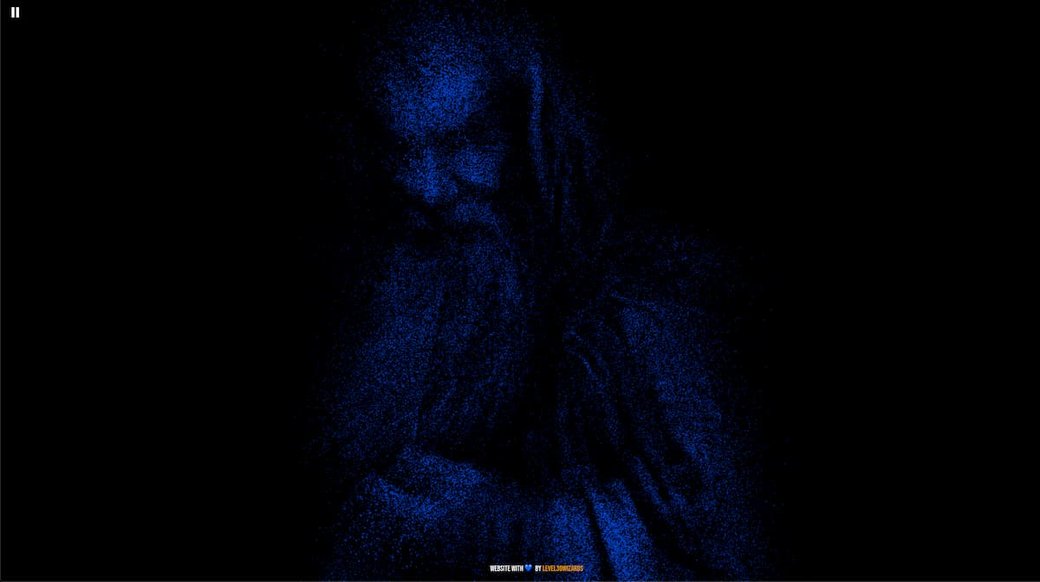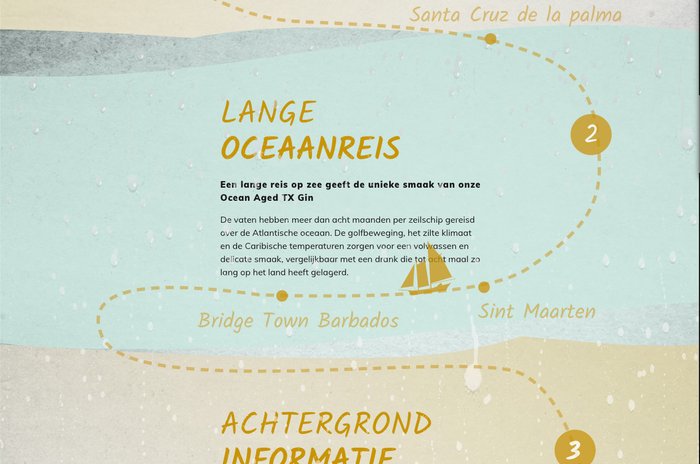Transforming an image to animating Particles with Web Audio
We're going to transform an image to particles and then animate those with values from Web Audio
At my company Level30Wizards, we experiment with web techniques to learn how we can implement those for clients. Check it out on our website Disclaimer: This article contains a lot of WebGL shader code, which I, as of today, don't understand.
Tech stack
- HTML
- CSS
- P5js to get audio values from audio clips
- WebPack for compiling
- ThreeJS / WebGL for creating and animating particles
Libraries
- ControlKit - GUI
- gsap - animation platform
- glslify - module system for GLSL
- stats.js - performance monitor
- Three.js - WebGL library
Goal
We want to transform a photo into particles and then animate those particles based on values we get from audio.
Threejs Scene
First of all, we create a new scene with Three.js
1// scene2this.scene = new THREE.Scene();34// camera5this.camera = new THREE.PerspectiveCamera(6 100,7 window.innerWidth / window.innerHeight,8 1,9 100010);11this.camera.position.z = 300;1213// renderer14this.renderer = new THREE.WebGLRenderer({ antialias: true, alpha: true });1516// clock17this.clock = new THREE.Clock(true);
Next to that we add some standard resize functions. Then, we initialize our particle function.
1initParticles() {2 this.particles = new Particles(this);3 this.scene.add(this.particles.container);4}56// Create a draw function7draw() {8 this.renderer.render(this.scene, this.camera);9}1011// Create an update function12update() {13 const delta = this.clock.getDelta();1415 if (this.particles) this.particles.update(delta);16}
Particles
Classes?! Well, this project is an experiment. So I combined work from other people into a new one. #FullStackOverflowDeveloper
1import * as THREE from "three";2import { gsap } from "gsap";34const glslify = require("glslify");56export default class Particles {7 constructor(webgl) {8 this.webgl = webgl;9 this.container = new THREE.Object3D();10 this.mapBass = 0;11 this.mapTremble = 0;12 this.mapMid = 0;13 this.mapLowMid = 0;14 this.mapHighMid = 0;15 this.root = document.documentElement;16 this.playPauseButton = document.querySelector(17 '[aria-label="toggle-music"]'18 );19 }
Initialize particles
This code will initialize the particle animation, load the audio file and gathers the audio values.
1init(src) {2 gsap.fromTo(3 ".loading",4 {5 autoAlpha: 1,6 },7 {8 duration: 0.5,9 autoAlpha: 0,10 }11 );1213 const loader = new THREE.TextureLoader();14 loader.load(src, (texture) => {15 this.texture = texture;16 this.texture.minFilter = THREE.LinearFilter;17 this.texture.magFilter = THREE.LinearFilter;18 this.texture.format = THREE.RGBFormat;1920 this.width = texture.image.width;21 this.height = texture.image.height;2223 this.initPoints(true);24 this.resize();25 this.hide();26 });2728 const s = (p) => {29 let audio, fft;3031 p.preload = () => {32 audio = p.loadSound("/audio/music-file.mp3", () => {33 this.playPauseButton.addEventListener("click", () => {34 if (audio.isPlaying()) {35 audio.pause();36 gsap.to("#pause", {37 autoAlpha: 0,38 duration: 0.15,39 });40 gsap.to("#play", {41 autoAlpha: 1,42 duration: 0.15,43 delay: 0.15,44 });45 } else {46 audio.loop();47 gsap.to("#play", {48 autoAlpha: 0,49 duration: 0.15,50 });51 gsap.to("#pause", {52 autoAlpha: 1,53 duration: 0.15,54 delay: 0.15,55 });56 }57 });58 });59 };60 p.setup = () => {61 fft = new p5.FFT();62 const allowButton = document.querySelector("#allow-music");6364 allowButton.addEventListener("click", () => {65 audio.loop();66 this.show();67 gsap.to([allowButton, ".container img"], {68 autoAlpha: 0,69 duration: 0.5,70 });71 });72 };73 p.draw = () => {74 fft.analyze();7576 const bass = fft.getEnergy("bass");77 const treble = fft.getEnergy("treble");78 const lowMid = fft.getEnergy("lowMid");79 const mid = fft.getEnergy("mid");80 const highMid = fft.getEnergy("highMid");8182 this.mapBass = p.map(bass, 0, 255, 0, 2.0);83 this.mapTremble = p.map(treble, 0, 255, 0, 2.0);84 this.mapLowMid = p.map(lowMid, 0, 255, 0, 2.0);85 this.mapMid = p.map(mid, 0, 255, 0, 2.0);86 this.mapHighMid = p.map(highMid, 0, 255, 0, 2.0);87 };88 };89 new p5(s);90}
Image to particles
This code was written by Bruno Imbrizi
1initPoints(discard) {2 this.numPoints = this.width * this.height;34 let numVisible = this.numPoints;5 let threshold = 0;6 let originalColors;78 if (discard) {9 // discard pixels darker than threshold #2210 numVisible = 0;11 threshold = 34;1213 const img = this.texture.image;14 const canvas = document.createElement("canvas");15 const ctx = canvas.getContext("2d");1617 canvas.width = this.width;18 canvas.height = this.height;19 ctx.scale(1, -1);20 ctx.drawImage(img, 0, 0, this.width, this.height * -1);2122 const imgData = ctx.getImageData(0, 0, canvas.width, canvas.height);23 originalColors = Float32Array.from(imgData.data);2425 for (let i = 0; i < this.numPoints; i++) {26 if (originalColors[i * 4 + 0] > threshold) numVisible++;27 }28 }2930 const uniforms = {31 uTime: { value: 0 },32 uRandom: { value: 1.0 },33 uDepth: { value: 100.0 },34 uSize: { value: 1.58 },35 uTextureSize: { value: new THREE.Vector2(this.width, this.height) },36 uTexture: { value: this.texture },37 uTouch: { value: null },38 // This variable was added to use audio values in the vertex shader39 music: { value: null },40 };4142 const material = new THREE.RawShaderMaterial({43 uniforms,44 vertexShader: glslify(require("../../../shaders/particle.vert")),45 fragmentShader: glslify(require("../../../shaders/particle.frag")),46 depthTest: false,47 transparent: true,48 });4950 const geometry = new THREE.InstancedBufferGeometry();5152 // positions53 const positions = new THREE.BufferAttribute(new Float32Array(4 * 3), 3);54 positions.setXYZ(0, -0.5, 0.5, 0.0);55 positions.setXYZ(1, 0.5, 0.5, 0.0);56 positions.setXYZ(2, -0.5, -0.5, 0.0);57 positions.setXYZ(3, 0.5, -0.5, 0.0);58 geometry.addAttribute("position", positions);5960 // uvs61 const uvs = new THREE.BufferAttribute(new Float32Array(4 * 2), 2);62 uvs.setXYZ(0, 0.0, 0.0);63 uvs.setXYZ(1, 1.0, 0.0);64 uvs.setXYZ(2, 0.0, 1.0);65 uvs.setXYZ(3, 1.0, 1.0);66 geometry.addAttribute("uv", uvs);6768 // index69 geometry.setIndex(70 new THREE.BufferAttribute(new Uint16Array([0, 2, 1, 2, 3, 1]), 1)71 );7273 const indices = new Uint16Array(numVisible);74 const offsets = new Float32Array(numVisible * 3);75 const angles = new Float32Array(numVisible);7677 for (let i = 0, j = 0; i < this.numPoints; i++) {78 if (discard && originalColors[i * 4 + 0] <= threshold) continue;7980 offsets[j * 3 + 0] = i % this.width;81 offsets[j * 3 + 1] = Math.floor(i / this.width);8283 indices[j] = i;8485 angles[j] = Math.random() * Math.PI;8687 j++;88 }8990 geometry.addAttribute(91 "pindex",92 new THREE.InstancedBufferAttribute(indices, 1, false)93 );94 geometry.addAttribute(95 "offset",96 new THREE.InstancedBufferAttribute(offsets, 3, false)97 );98 geometry.addAttribute(99 "angle",100 new THREE.InstancedBufferAttribute(angles, 1, false)101 );102103 this.object3D = new THREE.Mesh(geometry, material);104 this.container.add(this.object3D);105}
Cool, so now the image will be transformed to particles.
Updating Vertex Shader variables with ThreeJS
Now, we need to update values in the Vertex Shader for all the particles to animate. We do this by utilizing a RequestAnimationFrame that updates the WebGL values based on your refresh rate.
1update(delta) {2 if (!this.object3D) return;3 if (this.touch) this.touch.update();4 this.object3D.material.uniforms.music.value = Math.max(1, this.mapBass);56 this.object3D.material.uniforms.uTime.value += delta;7}
Vertex Shader
This is where it gets magical for me. I don't have a lot of experience with WebGL, Vertex shaders or Fragment shaders. But after tinkering a bit, I was able to use the music variable in the animation.
1// @author brunoimbrizi / http://brunoimbrizi.com23precision highp float;45attribute float pindex;6attribute vec3 position;7attribute vec3 offset;8attribute vec2 uv;9attribute float angle;1011uniform mat4 modelViewMatrix;12uniform mat4 projectionMatrix;1314// Create music variable15uniform float music;1617uniform float uTime;18uniform float uRandom;19uniform float uDepth;20uniform float uSize;21uniform vec2 uTextureSize;22uniform sampler2D uTexture;23uniform sampler2D uTouch;2425varying vec2 vPUv;26varying vec2 vUv;2728#pragma glslify: snoise2 = require(glsl-noise/simplex/2d)2930float random(float n) {31 return fract(sin(n) * 43758.5453123);32}3334void main() {35 vUv = uv;3637 // particle uv38 vec2 puv = offset.xy / uTextureSize;39 vPUv = puv;4041 // pixel color42 vec4 colA = texture2D(uTexture, puv);43 float grey = colA.r * 0.21 + colA.g * 0.71 + colA.b * 0.07;4445 // displacement46 vec3 displaced = offset;47 // randomise and utilize music variable48 displaced.xy += vec2(random(pindex) - 0.25, random(offset.x + pindex) - 0.25) * uRandom * (music * 0.2);49 float rndz = (random(pindex) + snoise_1_2(vec2(pindex * 0.1, music * 0.1)));50 displaced.z += rndz * (random(pindex) * uDepth) * (music * 6.0);51 // center52 displaced.xy -= uTextureSize * 0.5;5354 // touch55 float t = texture2D(uTouch, puv).r;56 displaced.z += t * 20.0 * rndz;57 displaced.x += cos(angle) * t * 20.0 * rndz;58 displaced.y += sin(angle) * t * 20.0 * rndz;5960 // particle size61 float psize = (snoise_1_2(vec2(uTime* music, pindex) * 0.5) + 2.0) * music * 0.5;62 psize *= max(grey, 0.2);63 psize *= uSize;6465 // final position66 vec4 mvPosition = modelViewMatrix * vec4(displaced, 1.0);67 mvPosition.xyz += position * psize;68 vec4 finalPosition = projectionMatrix * mvPosition;6970 gl_Position = finalPosition;71}
Fragment shader
To give some texture to the particles we add a fragment shader.
1// @author brunoimbrizi / http://brunoimbrizi.com23precision highp float;45uniform sampler2D uTexture;6uniform float uTime;78varying vec2 vPUv;9varying vec2 vUv;1011void main() {12 vec4 color = vec4(0.0);13 vec2 uv = vUv;14 vec2 puv = vPUv;1516 // pixel color17 vec4 colA = texture2D(uTexture, puv);1819 // greyscale20 float grey = colA.r * 0.21 + colA.g * 0.71 + colA.b * 0.07;21 vec4 colB = vec4(grey, grey, grey, 1.0);2223 // circle24 float border = 0.3;25 float radius = 0.5;26 float dist = radius - distance(uv, vec2(0.5));27 float t = smoothstep(0.0, border, dist);2829 uv = 2.0 * uv - 1.0;3031 // Double the speed32 float wave = sin(uTime * 2.0);3334 // Scale to make the circle bigger so it reaches the far edges35 float circle = (uv.x * uv.x + uv.y * uv.y) * 0.2;36 vec4 color1 = vec4(0.1, 0.2, 0.8, 1.0); // Red37 vec4 color2 = vec4(0.2, 0.1, 0.8, 1.0); // Blue3839 color = mix(color1, color2, circle + wave);40 // final color41 // color = colB;42 color.a = t;4344 gl_FragColor = color;45}
Finalize
Ofcourse, more goes into the experiment than all this code. But I don't think anyone will learn from the rest of it. By now I learned how to use ThreeJS to update variables in shaders, in an inefficient way. I understand how transforming an image to particles works, how you update a vertex shader and how you combine audio values with web animation.
Demo
Have a look at the demo to see how it all comes together. GitHub Repo
Thanks for reading!
I hope someone somewhere learned something via this post! If you did, please consider sharing the article. If you have some web animation concept or library you want to learn about, let me know!
Other posts you might like
How to develop a Web AR Facefilter with React and ThreeJS / React Three Fiber in 2021
September 09, 2021For the 3 year anniversary of 🧙🏼♂️ Level30Wizards we wanted to build something that's related…
Accessible Wavy Text Animation using React Hooks and Framer Motion
February 17, 2021In this article i'll recreate a wavy text animation we built with React Hooks and GSAP v3 but…
How we drove up sales with animation and storytelling
October 05, 2020“Good animation is invisible. You shouldn’t notice that you’re looking at animation. You want to…



